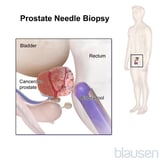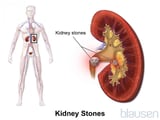what causes urine to back up into the kidneys
Urinary tract obstruction is a blockage that inhibits the menstruum of urine through its normal path (the urinary tract), including the kidneys, ureters, bladder, and urethra.
-
Blockage can exist complete or partial.
-
Blockage tin can pb to kidney impairment, kidney stones, and infection.
-
Symptoms can include pain in the side, decreased or increased urine flow, and urinating at dark.
-
Symptoms are more mutual if the blockage is sudden and complete.
-
Testing can include insertion of a urethral catheter, insertion of a viewing tube into the urethra, and imaging tests.
-
Treatment tin include measures to open a blocked path and to treat the cause of the blockage.
A blockage (obstacle) anywhere forth the urinary tract—from the kidneys, where urine is produced, to the urethra, through which urine leaves the body—tin increase pressure level within the urinary tract and dull the menstruation of urine. An obstruction may occur suddenly or develop slowly over days, weeks, or even months. An obstruction may completely or only partially block part of the urinary tract. Sometimes but 1 kidney is affected, but obstacle may affect both kidneys.
Hydronephrosis: A Distended Kidney
In hydronephrosis, the kidney is distended considering the menses of urine is obstructed. Urine backs upwardly behind the obstruction and remains in the kidney'southward small tubes and central collecting area (renal pelvis).
Normally, urine flows out of the kidneys at extremely low pressure. If the flow of urine is obstructed, urine backs upwards behind the signal of blockage, eventually reaching the small-scale tubes of the kidney and its collecting surface area (renal pelvis), swelling (distending) the kidney and increasing the pressure on its internal structures. Such kidney distention is called hydronephrosis. The elevated pressure due to the obstruction may ultimately damage the kidney and tin result in loss of its role. When the period of urine is obstructed, stones Stones in the Urinary Tract (calculi) are more than likely to form. An infection may develop when the flow of urine is obstructed because bacteria that enter the urinary tract are not flushed out. If both kidneys are obstructed, kidney failure Kidney Failure may result.
Long-standing distention of the renal pelvis and ureter can also inhibit the rhythmic muscular contractions that unremarkably movement urine down the ureter from the kidney to the bladder (peristalsis). Scar tissue may then replace the normal muscular tissue in the walls of the ureter, resulting in permanent damage.
Partial and consummate obstacle tend to cause similar problems, but nigh issues, and especially kidney damage, are more astringent when obstacle is complete.
Blockage may be partial or complete, affect 1 side or both sides, and develop quickly (acutely) or slowly (chronically). The most common causes overall are
The many other possible causes of urinary tract obstacle include the following:
-
Polyps in the ureter
-
Claret jell in the ureter
-
Tumors in or about the ureter
-
Formation of fibrous (scar) tissue in or around the ureter resulting from surgery, radiation therapy, or drugs (peculiarly methysergide)
-
Bulging of the lower stop of the ureter into the bladder (ureterocele)
-
Tumor, abscesses, and cysts of the bladder, cervix, uterus, prostate, or other pelvic organs
-
A big mass of carrion stuck in the rectum (rectal impaction)
Hydronephrosis of both kidneys tin can occur during pregnancy as the enlarging uterus compresses the ureters. Hormonal changes during pregnancy may worsen the problem by reducing the muscular contractions that commonly move urine down the ureters. This condition, ordinarily called hydronephrosis of pregnancy, usually resolves when the pregnancy ends, although the renal pelvis and ureters may remain somewhat distended later.
Symptoms depend on the cause, location, and duration of the obstruction. When the obstruction begins quickly and distends the bladder, ureter, and/or the kidney, information technology usually causes pain. If the kidney is distended, renal colic tin develop. Renal colic is an excruciating pain between the ribs and hip on the affected side that comes and goes every few minutes. The pain may extend into a testis or the vaginal area. People may have nausea and vomiting.
Obstruction of 1 ureter does not reduce how much people urinate. Obstacle tin stop or reduce urination if blockage affects the ureters from both kidneys or if information technology affects the urethra. Obstruction of the urethra or bladder outlet may cause pain, pressure, and distention of the bladder.
People who have slowly progressive obstacle that causes hydronephrosis may accept no symptoms, or they may take attacks of dull, aching discomfort in the flank (the part of the dorsum between the lower end of the ribs and the spine) on the affected side. Sometimes, a kidney rock temporarily blocks the ureter and causes hurting that occurs intermittently.
Obstruction that leads to hydronephrosis may cause vague digestive tract symptoms, such as nausea, vomiting, and abdominal hurting. These symptoms sometimes occur in children when hydronephrosis results from a birth defect in which the junction of the ureter and renal pelvis is also narrow (ureteropelvic junction obstruction).
-
Float catheterization
-
Imaging
Early diagnosis is important, considering virtually cases of obstruction tin be corrected and because a delay in treatment can lead to irreversible kidney damage. Doctors may doubtable obstacle because of a person's symptoms, such as renal colic, symptoms of bladder distention, or a decrease in the volume of urine. A distended kidney can rarely be felt in the flank, usually if the kidney is greatly enlarged in an baby or a child or a sparse adult. A distended bladder can sometimes be felt in the lower role of the abdomen but above the pubic bone.
Doctors depend on testing to make the diagnosis.
Float catheterization (insertion of a hollow, soft tube through the urethra) is ofttimes the first diagnostic examination done in people with symptoms that suggest the bladder is distended, such as pelvic pressure or distention. If the catheter drains a large corporeality of urine from the bladder, so either the bladder outlet or the urethra is obstructed. Many doctors exercise ultrasonography to determine whether the bladder is filled with a large amount of urine earlier doing bladder catheterization.
Blockage can usually exist relieved, but if relief takes besides long, the kidney can be damaged permanently. However, because i normally performance kidney is enough to sustain the body, permanent kidney failure is unlikely to develop unless both kidneys take been blocked for some time, usually at least a few weeks. The prognosis also depends on the crusade of obstruction. For example, an untreated infection is more than likely to crusade kidney damage than a kidney stone Stones in the Urinary Tract .
-
Relief of obstacle
Treatment usually aims to salve the cause of obstacle. For example, if the urethra is blocked because of a benign enlarged or malignant prostate, handling can include drugs, such as hormonal therapy Hormonal therapy Prostate cancer begins in a small area of the prostate gland, an organ found only in males. The gamble of prostate cancer increases every bit men age. Symptoms, such as difficulty urinating, a need to... read more  for prostate cancer, surgery, or enlargement of the urethra with dilators. Other treatments, such every bit lithotripsy or endoscopic surgery Stone removal Stones (calculi) are difficult masses that grade in the urinary tract and may crusade pain, bleeding, or an infection or cake of the flow of urine. Tiny stones may cause no symptoms, just larger stones... read more
for prostate cancer, surgery, or enlargement of the urethra with dilators. Other treatments, such every bit lithotripsy or endoscopic surgery Stone removal Stones (calculi) are difficult masses that grade in the urinary tract and may crusade pain, bleeding, or an infection or cake of the flow of urine. Tiny stones may cause no symptoms, just larger stones... read more  , may be needed to remove stones that block the flow of urine in the ureter or kidney.
, may be needed to remove stones that block the flow of urine in the ureter or kidney.
If the crusade of obstruction cannot exist rapidly corrected, particularly if in that location is infection, kidney failure, or severe pain, the urinary tract is tuckered. When acute hydronephrosis is acquired by an obstruction that is not easily relieved, urine that has accumulated above the obstacle can exist drained with a soft tube inserted through the back into the kidney (nephrostomy tube) or past insertion of a soft plastic tube that connects the float with the kidney (ureteral stent). Complications of nephrostomy tubes or ureteral stents can include displacement of the tube, infection, and discomfort. If the urethra is the site of an obstacle that must exist relieved rapidly, doctors insert a soft rubber catheter into the bladder to drain urine.
Source: https://www.merckmanuals.com/home/kidney-and-urinary-tract-disorders/obstruction-of-the-urinary-tract/urinary-tract-obstruction
0 Response to "what causes urine to back up into the kidneys"
Postar um comentário